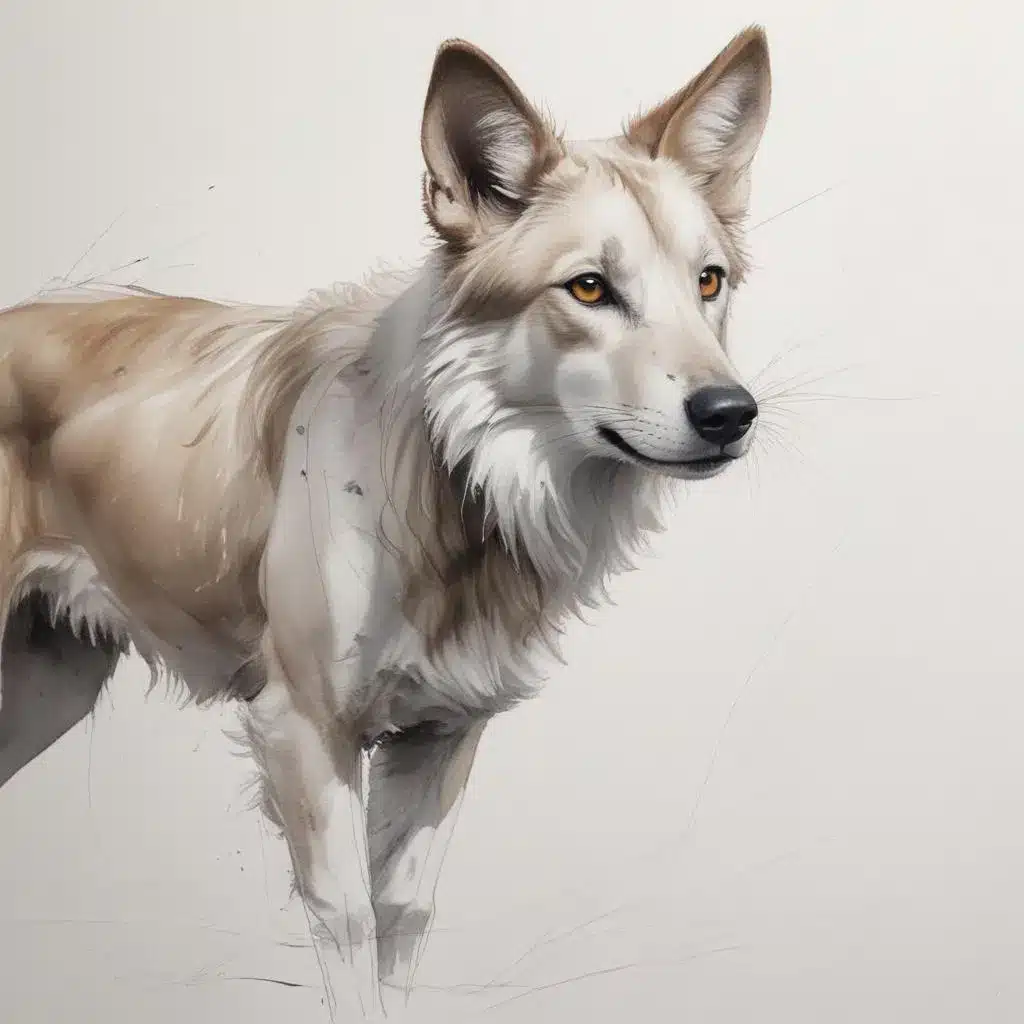
In the realm of art, the powerful interplay between line, mark-making, and expressive movement can elevate a simple sketch into a captivating, spirited depiction of life. Whether you’re working in pencil, charcoal, or paint, harnessing the energy and rhythm inherent in gestural techniques can breathe life into your animal drawings and paintings, imbuing them with a sense of dynamism and personality.
Now, this might seem counterintuitive…
Modern Painting Techniques
Gestural Lines
At the heart of this expressive approach lies the gestural line – bold, fluid strokes that capture the essence of movement and form. Rather than relying on rigid, precise outlines, gestural lines flow organically, responding to the subject’s energy and the artist’s own physical engagement with the medium. By allowing your hand to move freely across the surface, you can translate the animal’s stance, gait, or even its emotional state into the very textureand directionalflow of the line.
Expressive Marks
Complementing the gestural line, expressive marks add depth and character to your animal studies. These could take the form of energetic brushstrokes, dynamic scratches with a charcoal pencil, or even the expressive splattering of paint. The key is to let your marks reflect the inherent liveliness of your subject, whether that means capturing the coarse texture of fur, the smooth planes of a sleek feline, or the frenzied flapping of a bird’s wings.
Energetic Brush Strokes
In the realm of painting, energetic brushstrokes are a powerful tool for creating a sense of vitality and movement. Rather than carefully rendering every detail, embrace a more spontaneous approach, allowing the paint to flow and interact on the surface. Experiment with varied stroke lengths, directions, and levels of impasto to evoke the unique rhythms and textures of your animal subjects.
Pencil Drawing Tutorials
Sketching Dynamic Figures
When working in pencil, the challenge lies in translating the three-dimensional form of an animal into a two-dimensional drawing. Begin by quickly capturing the overall gestalt – the essential shape and posture of your subject. Then, use dynamic, gestural lines to delineate the major forms and suggest movement. Avoid rigid outlines in favor of flowing, expressive strokes that convey the energy of your animal.
Capturing Rhythm and Movement
A crucial aspect of bringing your animal sketches to life is the ability to capture rhythm and movement. Observe the natural cadence of your subject’s gait, the way its muscles flex and shift, or the fluttering of wings. Translate these dynamic elements through the rhythm and flow of your pencil marks, allowing the lines to undulate and pulse across the page.
Developing Characterful Drawings
Beyond just rendering the physical form, imbuing your animal drawings with a sense of personality and character is essential. Pay close attention to your subject’s facial features, body language, and overall demeanor. Use expressive marks and gestural lines to suggest the animal’s mood, whether it’s the alert gaze of a predator, the playful prance of a puppy, or the regal poise of a feline.
Creative Inspiration
Translating Lifelike Creatures
When sketching animals from life, strive to capture not just their outward appearance, but the essence of their being. Observe their movements, behaviors, and interactions with the environment. How do they carry themselves? What subtle cues reveal their inner state? Integrate these observations into your dynamic, gestural lines and expressive marks to create drawings that feel truly alive.
Imbuing Personality and Spirit
Beyond mere technical accuracy, the most captivating animal art evokes a deeper connection – a sense of the animal’s unique personality and spirit. Experiment with exaggerating certain features or emphasizing specific details to heighten the emotional resonance of your work. Let your artistic sensibilities guide you in translating the essence of your subject onto the page or canvas.
Exploring Naturalistic Poses
While dynamic, energetic poses can be incredibly engaging, don’t neglect the power of naturalistic, contemplative poses. Observe animals in their natural environments, capturing the quiet moments of rest, grooming, or subtle interactions. Use gestural lines and expressive marks to convey the tranquil rhythm and serenity of these scenes, inviting the viewer to slow down and connect with the subject on a deeper level.
Artistic Design Principles
Unity and Harmony
When composing your animal sketches and paintings, strive for a sense of unity and harmony that ties the various elements together. This could manifest in the consistent directionality of your gestural lines, the rhythmic repetition of expressive marks, or the harmonious color relationships that unify the composition.
Emphasis and Focal Points
Within your dynamic, energetic compositions, it’s important to establish clear emphasis and focal points that guide the viewer’s eye. Use strategic placement of your most expressive marks and gestural lines to draw attention to the most essential or captivating aspects of your animal subject.
Contrast and Variety
While harmony and unity are crucial, don’t be afraid to introduce contrast and variety to add visual interest and depth to your work. This could involve juxtaposing areas of intense gestural energy with calmer, more contemplative passages, or incorporating a range of mark-making techniques and line qualities to create a sense of visual dynamism.
Color Theory Fundamentals
Integrating color theory into your animal art can further enhance the sense of energy, mood, and character. Experiment with complementary color relationships to create a sense of vibrancy and tension, or employ chromatic expressionism to imbue your work with a particular emotional resonance.
By embracing the power of gestural lines, expressive marks, and a keen understanding of artistic design principles, you can elevate your animal sketches and paintings to new heights of energy, liveliness, and character. Remember to let your creative process be guided by close observation, a willingness to experiment, and a deep respect for the spirit and essence of your animal subjects. Unleash the rhythmic pulse of your materials and let your artistic voice shine through.
For more inspiration and in-depth tutorials on modern painting techniques, pencil drawing, and creative art processes, be sure to visit Pencil and Paint Muse.
Tip: Experiment with different media to discover your unique style